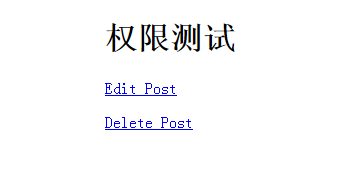- ubuntu12.04环境下使用kvm ioctl接口实现最简单的虚拟机
- Ubuntu 通过无线网络安装Ubuntu Server启动系统后连接无线网络的方法
- 在Ubuntu上搭建网桥的方法
- ubuntu 虚拟机上网方式及相关配置详解
CFSDN坚持开源创造价值,我们致力于搭建一个资源共享平台,让每一个IT人在这里找到属于你的精彩世界.
这篇CFSDN的博客文章Laravel5.1框架自带权限控制系统 ACL用法分析由作者收集整理,如果你对这篇文章有兴趣,记得点赞哟.
本文实例讲述了Laravel5.1框架自带权限控制系统 ACL用法。分享给大家供大家参考,具体如下:
Laravel在5.1.11版本中加入了Authorization,可以让用户自定义权限,今天分享一种定义权限系统的方法.
1. 创建角色与权限表 。
使用命令行创建角色与权限表:
|
1
|
php artisan make:migration create_permissions_and_roles --create=permissions
|
之后打开刚刚创建的文件,填入下面的代码:
|
1
2
3
4
5
6
7
8
9
10
11
12
13
14
15
16
17
18
19
20
21
22
23
24
25
26
27
28
29
30
31
32
33
34
35
36
37
38
39
40
41
42
43
44
45
46
47
48
49
50
|
public
function
up()
{
Schema::create(
'roles'
,
function
(Blueprint
$table
) {
$table
->increments(
'id'
);
$table
->string(
'name'
);
$table
->string(
'label'
);
$table
->string(
'description'
)->nullable();
$table
->timestamps();
});
Schema::create(
'permissions'
,
function
(Blueprint
$table
) {
$table
->increments(
'id'
);
$table
->string(
'name'
);
$table
->string(
'label'
);
$table
->string(
'description'
)->nullable();
$table
->timestamps();
});
Schema::create(
'permission_role'
,
function
(Blueprint
$table
) {
$table
->integer(
'permission_id'
)->unsigned();
$table
->integer(
'role_id'
)->unsigned();
$table
->foreign(
'permission_id'
)
->references(
'id'
)
->on(
'permissions'
)
->onDelete(
'cascade'
);
$table
->foreign(
'role_id'
)
->references(
'id'
)
->on(
'roles'
)
->onDelete(
'cascade'
);
$table
->primary([
'permission_id'
,
'role_id'
]);
});
Schema::create(
'role_user'
,
function
(Blueprint
$table
) {
$table
->integer(
'user_id'
)->unsigned();
$table
->integer(
'role_id'
)->unsigned();
$table
->foreign(
'role_id'
)
->references(
'id'
)
->on(
'roles'
)
->onDelete(
'cascade'
);
$table
->foreign(
'user_id'
)
->references(
'id'
)
->on(
'users'
)
->onDelete(
'cascade'
);
$table
->primary([
'role_id'
,
'user_id'
]);
});
}
public
function
down()
{
Schema::drop(
'roles'
);
Schema::drop(
'permissions'
);
Schema::drop(
'permission_role'
);
Schema::drop(
'role_user'
);
}
|
上面的代码会创建角色表、权限表、角色与权限的中间表以及角色与用户的中间表.
2. 创建模型 。
接下来使用命令行分别创建角色与权限模型:
|
1
2
|
php artisan make:model Permission
php artisan make:model Role
|
然后分别打开Permission.php、Role.php 以及 User.php ,加入下面的代码:
|
1
2
3
4
5
|
// Permissions.php
public
function
roles()
{
return
$this
->belongsToMany(Role::
class
);
}
|
|
1
2
3
4
5
6
7
8
9
10
|
// Role.php
public
function
permissions()
{
return
$this
->belongsToMany(Permission::
class
);
}
//给角色添加权限
public
function
givePermissionTo(
$permission
)
{
return
$this
->permissions()->save(
$permission
);
}
|
|
1
2
3
4
5
6
7
8
9
10
11
12
13
14
15
16
17
18
19
20
21
22
23
24
25
|
// User.php
public
function
roles()
{
return
$this
->belongsToMany(Role::
class
);
}
// 判断用户是否具有某个角色
public
function
hasRole(
$role
)
{
if
(
is_string
(
$role
)) {
return
$this
->roles->contains(
'name'
,
$role
);
}
return
!!
$role
->intersect(
$this
->roles)->
count
();
}
// 判断用户是否具有某权限
public
function
hasPermission(
$permission
)
{
return
$this
->hasRole(
$permission
->roles);
}
// 给用户分配角色
public
function
assignRole(
$role
)
{
return
$this
->roles()->save(
Role::whereName(
$role
)->firstOrFail()
);
}
|
上面的代码实现了给角色分配权限及给用户分配角色,然后还提供了判断用户是否具有某角色及某权限的方法.
之后就给使用Laravel提供的Authorization来定义权限控制了,打开 /app/Providers/AuthServiceProvider.php 文件,在 boot() 中添加代码:
|
1
2
3
4
5
6
7
8
9
10
|
public
function
boot(GateContract
$gate
)
{
parent::registerPolicies(
$gate
);
$permissions
= \App\Permission::with(
'roles'
)->get();
foreach
(
$permissions
as
$permission
) {
$gate
->define(
$permission
->name,
function
(
$user
)
use
(
$permission
) {
return
$user
->hasPermission(
$permission
);
});
}
}
|
通过上面的方法就定义好了各个权限。下面就该填充数据了.
3. 填充数据 。
为方便起见,这里使用 tinker 命令行工具来添加几条测试数据:
|
1
|
php artisan tinker
|
之后进入命令行,依次输入下列命令:
|
1
2
3
4
5
6
7
8
9
10
11
12
13
14
15
16
17
18
19
20
21
22
23
24
25
26
27
28
29
30
|
// 改变命名空间位置,避免下面每次都要输入 App
namespace
App
// 创建权限
$permission_edit
=
new
Permission
$permission_edit
->name =
'edit-post'
$permission_edit
->label =
'Can edit post'
$permission_edit
->save()
$permission_delete
=
new
Permission
$permission_delete
->name =
'delete-post'
$permission_delete
->label =
'Can delete post'
$permission_delete
->save()
// 创建角色
$role_editor
=
new
Role
$role_editor
->name =
'editor'
;
$role_editor
->label =
'The editor of the site'
;
$role_editor
->save()
$role_editor
->givePermissionTo(
$permission_edit
)
$role_admin
=
new
Role
$role_admin
->name =
'admin'
;
$role_admin
->label =
'The admin of the site'
;
$role_admin
->save()
// 给角色分配权限
$role_admin
->givePermissionTo(
$permission_edit
)
$role_admin
->givePermissionTo(
$permission_delete
)
// 创建用户
$editor
= factory(User::
class
)->create()
// 给用户分配角色
$editor
->assignRole(
$role_editor
->name)
$admin
= factory(User::
class
)->create()
$admin
->assignRole(
$role_admin
->name)
|
上面我们创建了两个权限:edit-post 和 delete-post,然后创建了 editor 和 admin 两个角色,editor 角色拥有 edit-post 的权限,而 admin 两个权限都有。之后生成了两个用户,分别给他们分配了 editor 和 admin 的角色,即:ID 1 用户拥有 editor 角色,因此只有 edit-post 权限,而 ID 2 用户拥有 admin 角色,因此具有 edit-post 和 delete-post 权限。下面我们来验证下是否正确.
打开 routes.php 文件:
|
1
2
3
4
|
Route::get(
'/'
,
function
() {
$user
= Auth::loginUsingId(1);
return
view(
'welcome'
);
})
|
上面我们先验证 ID 1 用户的权限,然后修改 /resources/views/welcome.blade.php 文件:
|
1
2
3
4
5
6
7
8
9
10
11
12
13
14
15
16
17
18
19
|
<!DOCTYPE html>
<html>
<head>
<title>Laravel</title>
</head>
<body>
<h1>权限测试</h1>
<p>
@can(
'edit-post'
)
<a href=
"#"
rel=
"external nofollow"
rel=
"external nofollow"
>Edit Post</a>
@endcan
</p>
<p>
@can(
'delete-post'
)
<a href=
"#"
rel=
"external nofollow"
rel=
"external nofollow"
>
Delete
Post</a>
@endcan
</p>
</body>
</html>
|
在视图中我们通过 Laravel 提供的 @can 方法来判断用户是否具有某权限.
打开浏览器,访问上面定义的路由,可以看到视图中只出现了 Edit Post 链接。之后我们修改路由中用户ID为 2 ,然后再次刷新浏览器,可以看到,这次同时出现了 Edit Post 和 Delete Post 两个链接,说明我们定义的权限控制起作用了.

希望本文所述对大家基于Laravel框架的PHP程序设计有所帮助.
原文链接:https://blog.csdn.net/luyaran/article/details/53539022 。
最后此篇关于Laravel5.1框架自带权限控制系统 ACL用法分析的文章就讲到这里了,如果你想了解更多关于Laravel5.1框架自带权限控制系统 ACL用法分析的内容请搜索CFSDN的文章或继续浏览相关文章,希望大家以后支持我的博客! 。
场景:WAMP 服务器、InnoDB 表、自动递增唯一 ID 字段 [INT(10)]、100 多个并发 SQL 请求。如果需要,也应使用 VB.Net。 我的数据库有一个自动递增字段,用于为每个存储

我是一名优秀的程序员,十分优秀!